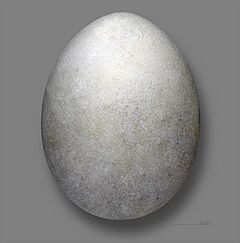Yelkouan shearwater facts for kids
Quick facts for kids Yelkouan shearwater |
|
|---|---|
 |
|
| Conservation status | |
| Scientific classification | |
| Genus: |
Puffinus
|
| Species: |
yelkouan
|
| Synonyms | |
|
Procellaria yelkouan Acerbi, 1827 |
|
The yelkouan shearwater (Puffinus yelkouan) is a medium-sized seabird. It is part of the Procellariidae family, which includes many types of seabirds. This bird is also known as the Levantine shearwater or Mediterranean shearwater. It was once thought to be a type of Manx shearwater.
Contents
About the Yelkouan Shearwater's Name
The yelkouan shearwater was first described in 1827. An Italian naturalist named Giuseppe Acerbi gave it its scientific name. He found these birds near the Bosphorus in Turkey. The word Puffinus comes from an old English word for "puffin." The specific name yelkouan is Turkish. It means "wind chaser," which perfectly describes how this bird flies.
This bird is considered "monotypic." This means it does not have any subspecies. It is a unique species on its own. It was once grouped with the Manx shearwater. Later, it was also linked to the Balearic shearwater. Now, scientists see it as its own distinct species.
What Does the Yelkouan Shearwater Look Like?
The yelkouan shearwater is about 30 to 35 centimeters (12 to 14 inches) long. Its wingspan can be 70 to 84 centimeters (28 to 33 inches). It has a special way of flying. It dips from side to side on stiff wings. Its wingtips almost touch the water as it glides. This flight style is called "shearing."
When it flies, it looks like a cross in the sky. Its wings are held straight out from its body. As it turns, you see its dark brown upper parts. Then, you see its paler white undersides. This makes it seem to change color as it flies low over the sea.
These birds are usually quiet when they are out at sea. But at night, their breeding colonies become very noisy. They make loud, cackling calls. These calls are higher pitched than those of the Manx shearwater.
The yelkouan shearwater looks different from the Balearic shearwater. The Balearic shearwater is brown all over. The yelkouan shearwater has a clearer contrast between its dark top and white bottom. It is very similar to the black-and-white Manx shearwater. It can be hard to tell them apart if they are seen outside their usual areas.
Where Do Yelkouan Shearwaters Live?
Yelkouan shearwaters make their nests on islands. They also nest on coastal cliffs. You can find them breeding in the eastern and central Mediterranean Sea. Most of them stay in this sea during winter. However, a few will fly into the Atlantic Ocean in late summer.
Yelkouan Shearwater Behavior and Life
These birds build their nests in burrows. A burrow is a hole or tunnel dug by an animal. They only visit their burrows at night. This helps them avoid predators like large gulls.
Yelkouan shearwaters are very social birds. They like to be in groups. You can often see many of them together from boats or cliffs. This is especially true in the autumn. They eat fish and molluscs, like snails or clams. Sometimes, they follow fishing boats. They look for leftover scraps that are thrown into the water.
Protecting the Yelkouan Shearwater
The yelkouan shearwater faces some dangers. New holiday resorts are being built near their nesting sites. This can disturb them. Animals like rats and cats also pose a threat. For example, on Le Levant Island, cats kill many birds each year. This could cause the birds to disappear from that area.
The IUCN (International Union for Conservation of Nature) keeps track of species. The yelkouan shearwater was once listed as "least concern." This meant it was not in much danger. But new studies showed it was rarer than thought. So, its status was changed. In 2008, it became "near threatened." In 2012, it was listed as "vulnerable." This means it is at high risk of becoming extinct in the wild. Protecting these birds and their homes is very important.



